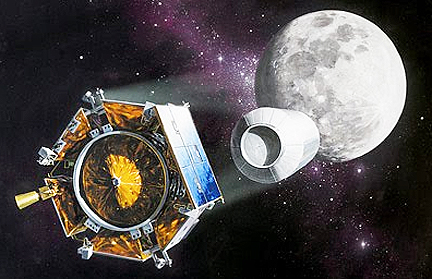
Artistic rendition of the OCO-2 satellite, courtesy of NASA.
....while NASA finds a new launch vehicle and fixes a problem in the spacecraft reaction wheel assemblies. After two launch failures with Orbital Sciences Corp.’s Taurus XL solid-fuel rocket, NASA has decided to try to launch its replacement on another vehicle. Possibilities include the Pegasus XL, Falcon 9, Delta II and Atlas V, according to Jim Norman, director of launch services at NASA headquarters. NASA pulled OCO-2 off the Taurus XL because company and government failure review boards were unable to pinpoint the precise cause for the back-to-back mishaps, Norman says. “We don’t have a root cause, so we just felt it was too high-risk to continue,” he says.
The agency and Orbital Sciences signed a bilateral contract modification Feb. 2 that terminates Orbital’s task order to launch OCO-2 under its NASA Launch Services II (NLS-II) contract. The action does not end Orbital’s NLS-II contract, which gives NASA different launch options under a “catalogue” approach. The U.S. space agency has released a new request for launch service proposals that includes the OCO-2 mission, along with the Soil Moisture Active Passive (SMAP) satellite and the Joint Polar Satellite System (JPSS-1). Once one is awarded, NASA anticipates the normal 27-month turnaround time before launch of OCO-2, which was originally scheduled to fly in February 2013. That slipped to July 2014 because of the reaction wheel issues, NASA says. “There will be an impact to the original OCO-2 launch-readiness date of February 2013,” the agency says. “However, we do not yet know how severe the impact will be.”
The initial OCO spacecraft, which was designed to produce global maps of carbon dioxide sources and sinks for climate-change studies, was lost on Feb. 24, 2009. The Taurus XL fairing protecting it during the early phases of ascent failed to separate as planned, and pulled the spacecraft into the South Pacific. After that mishap, Orbital Sciences engineers modified the fairing-separation mechanism on the Taurus XL from a system using hot gas generated by pyrotechnics to a cold-gas system driven by bottled nitrogen, and made other risk-mitigation changes. But the new design also failed to separate the fairing on the Taurus XL that launched NASA’s $424 million Glory mission on March 4, 2011, sending it to a Pacific splashdown as well.
An Orbital spokesman said that while the cold-gas separation mechanism has worked on subsequent launches of the company’s Minotaur rocket, he was not prepared to comment on whether the company will rebid the OCO-2 launch. Orbital Sciences also provides the spacecraft bus for the OCO-2 mission, based on its LEOStar-2 design. Under the NLS contracts, NASA will be refunded about 25 percent of the cost of the OCO-1 launch. By terminating the OCO-2 mission order a month after the Glory failure, the government will be paid back half of what it had spent for that work, according to Norman.
While specific contract figures are proprietary, NLS launches in the Taurus XL class under the catalogue in effect when OCO-1 was lost fell into the $30-75 million range. Since then the contract range has been raised to $22-114 million, NASA says. Earth scientists still have a source of global carbon data in Japan’s Greenhouse Gases Observing Satellite “Ibuki,” which was launched in 2009. But the Japanese orbiter returns “more than a factor of 100 fewer observations” during an orbit, and with limited coverage over the oceans, according to NASA. Delays in receiving ocean data from OCO-2 will hamper research, since oceans are an important sink for carbon dioxide. (Source: Aviation Week)

